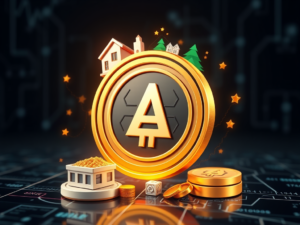Real-world asset (RWA) tokenization is redefining how we perceive and interact with value. By converting ownership rights of tangible and intangible assets—such as real estate, U.S. Treasuries, commodities, and intellectual property—into blockchain-based digital tokens, tokenization enables fractional ownership, 24/7 liquidity, and programmable compliance. According to Boston Consulting Group, the tokenized RWA market could reach $16 trillion by 2030, with the World Economic Forum projecting that 10% of global GDP will be stored on blockchain by 2027.
The process involves creating a digital “twin” of an asset on-chain, which can be traded, collateralized, or integrated into decentralized finance (DeFi) protocols. This not only democratizes access to high-value assets but also enhances transparency and efficiency in asset management. From tokenized carbon credits to luxury real estate, the scope of RWA tokenization is expanding rapidly.
Institutional Pioneers: BlackRock and Franklin Templeton
Two of the most significant institutional players in this space are BlackRock and Franklin Templeton, both of which have launched tokenized funds that bring traditional financial instruments on-chain.
In March 2024, BlackRock introduced the BUIDL Fund (BlackRock USD Institutional Digital Liquidity Fund) on Ethereum, in partnership with Securitize. BUIDL tokenizes U.S. Treasury bills and repurchase agreements, offering daily yield directly to investors’ wallets. The fund operates across Ethereum, Solana, and other blockchains, and is accessible only to accredited investors under Rule 506(c). BUIDL tokens are transferable 24/7 among pre-approved investors, and the fund is backed 1:1 by real-world assets.
Meanwhile, Franklin Templeton has launched the Franklin OnChain U.S. Government Money Fund (FOBXX), the first U.S.-registered mutual fund to record ownership on public blockchains like Stellar, Polygon, and Arbitrum. Shares are issued as BENJI tokens, enabling peer-to-peer transfers and integration with digital wallets. As of mid-2025, the fund manages over $760 million in assets, offering a 7-day effective yield of 4.13%.
Regulatory Fragmentation: A Global Patchwork
Despite the momentum, RWA tokenization faces a fragmented regulatory landscape. In the United States, the SEC applies existing securities laws to tokenized assets, often using the Howey Test to determine classification. This creates uncertainty, particularly around whether tokens represent securities, commodities, or property.
In contrast, the European Union’s MiCA regulation provides a more structured framework, especially for stablecoins and tokenized securities. Singapore and Switzerland have emerged as leaders in regulatory clarity. The Monetary Authority of Singapore (MAS) applies a “same activity, same risk, same regulation” principle, while Switzerland’s FINMA tailors oversight based on asset type. However, jurisdictional challenges remain a major hurdle for cross-border issuance and trading.

Infrastructure and Interoperability: The Backbone of Tokenization
The success of RWA tokenization depends on robust infrastructure. Smart contracts automate compliance, interest payments, and asset transfers, reducing reliance on intermediaries. However, they must be rigorously audited to prevent exploits. Interoperability is also critical—solutions like Chainlink’s CCIP and LayerZero aim to enable seamless cross-chain asset movement.
Custody is another key concern. Institutions like BNY Mellon and Anchorage Digital offer qualified custodial services for tokenized assets, ensuring compliance with traditional asset management standards. These developments are essential for bridging the gap between decentralized and traditional finance.
Beyond Bonds: Expanding Use Cases in Real Estate and ESG
While tokenized treasuries dominate early adoption, the technology is expanding into real estate, carbon credits, luxury goods, and fine art. Platforms like RealT allow users to own fractions of rental properties, while Toucan Protocol and Flowcarbon are pioneering carbon credit tokenization. These use cases highlight tokenization’s potential to democratize access to previously exclusive markets and align with ESG goals.
For example, a retail investor can now own a fraction of a Manhattan apartment or a Picasso painting—without needing millions in capital or complex legal arrangements. This shift is not just financial but cultural, redefining what it means to “own” something in a digital-first world.
From Pilot to Infrastructure: The Institutional Shift
The narrative around RWA tokenization is shifting from speculative hype to infrastructure deployment. Institutions are no longer asking “if” but “how” to tokenize their portfolios. BlackRock’s $10 trillion tokenization vision and Franklin Templeton’s multi-chain strategy signal a long-term commitment to blockchain-based finance.
As regulatory clarity improves and interoperability solutions mature, tokenization is poised to become a foundational layer of global finance. With trillions in assets waiting to be unlocked, RWA tokenization is not just a trend—it’s a structural transformation.





